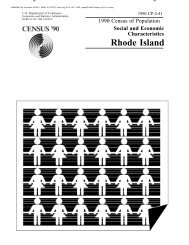Untitled - Rhode Island Historical Society
Untitled - Rhode Island Historical Society
Untitled - Rhode Island Historical Society
Create successful ePaper yourself
Turn your PDF publications into a flip-book with our unique Google optimized e-Paper software.
-€ :=<br />
=:':?<br />
:i<br />
=E<br />
€<br />
a<br />
::<br />
,a<br />
=<br />
110 "WAS SHE CLOTHED \rITH THE RENTS PAID FOR THESE \(/RETCHED ROOMS?"<br />
mills, like those in other <strong>Rhode</strong> <strong>Island</strong> textile factories, labored in family units<br />
of men, women, and children-often as young as eight years old-in order to<br />
earn enough money to survive. Unregulated by the state, working conditions in<br />
the factories were brutal.t Female operatives made up an increasingly large part<br />
of the work force. Employed as unskilled rvorkers, they were forced to stand for<br />
long periods of time, and they were frequentiv at the mercy of unscrupulous or<br />
immoral supervisors. Married women operatives returned home at night to care<br />
for their families in squalid and inadequate housing, o{ten provided by their<br />
employers. An increasingly large percenrage of the rvork force in Valley Falls<br />
and elsewhere in <strong>Rhode</strong> <strong>Island</strong> were recenr immigrants. Irish, English, and<br />
French Canadian workers were predominanr in the Chace mills.s<br />
Although chace had not addressed the sordid living and working conditions of<br />
factory operatives in her public reform initiatives, she had made personal efforts<br />
to ameliorate the harshness of life for the workers in Valley Falls. In the mid-<br />
1860s she had led a temperance crusade aimed at closing local rum shops, a<br />
measure intended to benefit workers by eliminating a drain on family income<br />
and improving family relations in workers' homes.e During that time chace and<br />
her husband were instrumental in starting an evening school "especially for mill<br />
workers, who could not attend the public day schools" in Valley Falls.'0 In<br />
addition, Chace and her daughters initiated a sewing class ar their home, and<br />
they provided its members, who were mainly young operatives, with reading<br />
material.lt Chace also attempted to establish an evening "reading room" for the<br />
Valley Falls factory workers, an initiative that failed, her daughter Lillie later<br />
wrote, "probably because Mrs. Chace insisted on providing periodicals of a<br />
character that were too intellectual."l2 These efforts in the 1860s and 1870s<br />
derived mainly from chace's sense of personal responsibility toward the operatives<br />
in her town, however, and did not encompass any institutional changes or<br />
critiques of the industrial system itself.<br />
By the mid-seventies Chace had expanded her personal efforts to include the<br />
needs of female mill workers in Valley Falls by establishing a kindergarten<br />
there.t3 The national kindergarten movement was popular among activist<br />
women, and Chace had undoubtedly conceived her own project after hearing<br />
about other kindergartens founded and staffed by woman reformers.'a Her<br />
kindergarten lasted for about seven or eight years. Differing from her earlier<br />
efforts to assuage the harshness of factory life, it drew not only children from<br />
families of factory workers but other children as well, including her own grandchildren."<br />
The kindergarten was an acknowledgment that workers in her family's<br />
mills suffered from the policies of the millowner as well as from their own<br />
ignorance or intemperance. In an article praising Chace's "noble work" in<br />
founding the kindergarten, <strong>Rhode</strong> <strong>Island</strong> suffrage organizer M. \7. Campbell<br />
stressed that it was established for the children "of the operatives in the mills of<br />
the Valley Falls manufacturing company" and was "designed to include such<br />
children as are not old enough to attend the public schools and are turned into<br />
the streets with no care during the day." The kindergarten was "entirely free,"<br />
Campbell noted.'6<br />
Chace ended her public silence on the abuses in the mills in the early 1880s. It is<br />
not clear why she chose this particular moment to speak out, although her<br />
dwindling physical energies may have persuaded her to address the issue in a<br />
timely fashion. Her practical work with the kindergarten undoubtedly increased<br />
her awareness of the grim conditions in the mill and its environsl her colleagues<br />
in the suffrage movement may also have urged her to take a public stand











